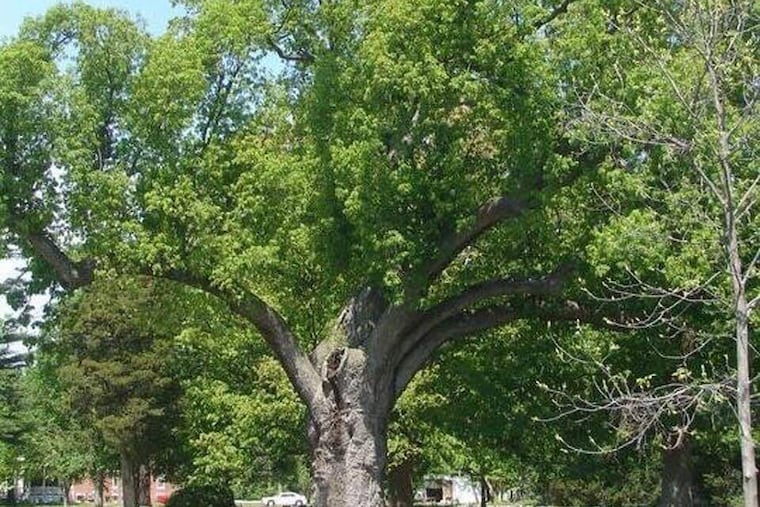An obituary for the late, great 600-year-old Salem Oak Tree of Salem, New Jersey
Her friends benefitted from her stately bearing, her ongoing endurance, and her deep roots that preceded not only the birth of this nation, but the European settlement of its lands.

Last month, the Salem Oak, the tallest white oak tree in New Jersey, toppled within the grounds of Salem Friends Meeting. In its honor, Meeting member Jessica Waddington wrote this obituary of the beloved county landmark.
On Thursday, June 6 at around 6:00 in the evening, the stately Salem Oak lay down, after standing tall for an estimated 600 years. She was at home, in the Salem Friends Burial Ground on Broadway, in the small historic town of Salem, N.J.
She had battled time, gravity, and Mother Nature for several hundred years, losing several limbs and requiring a great deal of care, before finally succumbing. She was surrounded by her descendants, the town that loved her, and a few hundred deceased Friends, all of whom benefited from her stately bearing, her ongoing endurance, and her deep roots that preceded not only the birth of this nation, but the European settlement of its lands.
The Salem Oak is believed to have been part of the original forest that covered Salem County before Salem was established in 1675 by an English Quaker named John Fenwick. Legend states that Fenwick signed a treaty with the local Lenni Lenape under the shade of the Oak’s wide-reaching branches. This was one of the few treaties with Native Americans that has never been broken, and the Quakers of Salem continue to have a strong relationship with the Lenni Lenape. Fenwick would later build a homestead not far from the mighty tree.
The area around the tree became a Quaker Burial Ground. Betsy Ross’s father was buried beneath the oak’s branches, and generations of Quakers have been, and continue to be, laid to rest there.
»READ MORE: He wants to learn about the ‘real’ Philly — by riding every single bus, train, and trolley run by SEPTA
The Salem Oak’s life span was double the 300-year average of most white oaks. In that time, she witnessed the clearing of her forest home and many other events that history has forgotten. She saw Lenni Lenape, early Quakers, European settlers, free African Americans, and their descendants, grow, build, and gather around her. She watched as Revolutionary War soldiers marched through her peaceful town. She impressed Charles Lindbergh with her fall foliage as he flew over Salem on Oct. 21, 1927, on his way from Atlantic City to Wilmington, in celebration of his solo trip across the Atlantic Ocean. She saw travelers and shipments of goods arriving at the Salem port down the street, and witnessed the birth of industry in Salem, as a huge bottling plant was built behind her.
The mighty Oak watched generations bid farewell to their loved ones as they were laid to rest around her. She offered silent comfort to those who came to visit their deceased friends and family, embracing them with the shelter and cool shade of her vast canopy. She offered a peaceful place for sunrise services, social gatherings, and quiet reflection. She enticed hundreds of children to try to stretch their arms around her massive trunk and provided them with a giant prop to run around and hide behind while playing. And she inspired local artists to try to capture her beauty, her significance, her peacefulness, her impressive stature, and her sheer awesomeness, in every medium.
In 2000, she was bestowed the honor of being named a Millennial Landmark Tree, through the America the Beautiful Fund. This recognized her as one of the top 50 trees in the country with historical significance. In 2016, she was declared the largest White Oak in New Jersey by the Department of Environmental Protection. At that time, she towered 103 feet tall, with a circumference of 22 feet, 4 inches. She had a crown fit for royalty, spanning 104 feet.
The Salem Oak is survived by countless descendants. Many of her children are planted in backyards, cemeteries, parks, and along streets throughout Salem City and Salem County. In 1875, one of her seedlings, the Centennial Oak, took root in the Salem Presbyterian Cemetery on Grant Street in Salem. In 1932, in commemoration of George Washington’s 200th birthday, another of her seedlings was planted along the George Washington Memorial Parkway in Virginia. This is the road that leads to Mount Vernon, our first president’s home. And since she fell, many past residents of Salem have reached out, stating that they have planted some of her seedlings in the yards of their new homes across the United States.
Numerous institutions, groups, and businesses throughout Salem County adopted her name and her image over the years. She will continue to live on, through her descendants, and in the adaptive use of her name and her mighty silhouette.
The Salem Monthly Meeting of the Religious Society of Friends cared lovingly, and at great expense, for the Oak for the last half of her life. They are carefully coordinating the safe and respectful removal of the wood from private property and will work to make small pieces available to locals. They appreciate the importance of the Oak and thank everyone for the outpouring of love and cherished memories that have been shared since the Oak fell. They request the public’s consideration at this time, to remain outside of the cemetery walls, and have respect for the Oak, the burial grounds, and the families of those buried beneath her.